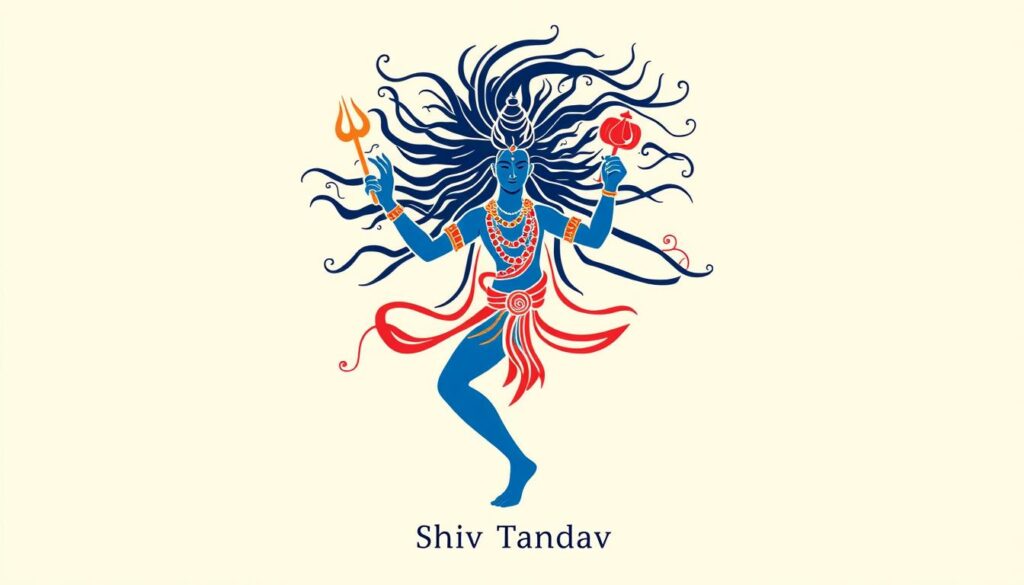
Did you know the Sanskrit hymn, Shiva Tandava Stotram, has 15 verses? Each verse talks about fearless Shiva and his eternal beauty. This powerful song, written by Ravana, a famous devotee, tells about Lord Shiva’s cosmic dance. This dance is said to remove negative energies.
Chanting the Stotram right can give you great power, beauty, and mental strength. It also cleanses the air of negative vibes.
Key Takeaways
- Shiva Tandava Stotram is a sacred Sanskrit hymn composed by Ravana, a renowned devotee of Lord Shiva.
- The hymn describes the cosmic dance of Lord Shiva, which is believed to eliminate negative energies.
- Correct chanting of the Stotram can provide immense spiritual, mental, and physical benefits.
- Understanding the proper pronunciation and rhythm is crucial for deriving the full benefits of the Stotram.
- Regular practice and devotion are essential for mastering the chanting of Shiva Tandava Stotram.
Understanding the Origins of Shiva Tandava Stotram

Ravana, the legendary demon king of Lanka, was a devoted Shiva follower and a Sanskrit scholar. He wrote the Shiva Tandava Stotram, a famous Sanskrit hymn. Ravana used a drum to set the rhythm for his verses.
The Story of Ravana’s Devotion
Ravana’s story is both fascinating and complex. Despite his fearsome image, he was deeply devoted to Lord Shiva. He tried to lift Mount Kailash to impress Shiva, but Shiva crushed his fingers in anger.
To make amends, Ravana wrote and sang the Shiva Tandava Stotram. This showed his great Sanskrit skills and devotion.
Historical Significance of the Hymn
The Shiva Tandava Stotram is very important historically. It shows Ravana’s deep connection with Lord Shiva. The hymn has 1,008 verses and was written on Mount Kailash’s South Face.
The scar on the mountain is a reminder of Ravana’s attempt to lift it.
Sanskrit Scholar Ravana’s Composition
Ravana was a true Renaissance man, known for his knowledge in many areas. The Shiva Tandava Stotram reflects his scholarly talent and spiritual bond with Shiva. It’s written in a special meter, showing his mastery of Sanskrit.
“Ravana sang hymns in praise of Shiva for a thousand years, and received great power from the Lord, including an invincible sword called Chandrahasa.”
The Power and Significance of Shiva’s Cosmic Dance
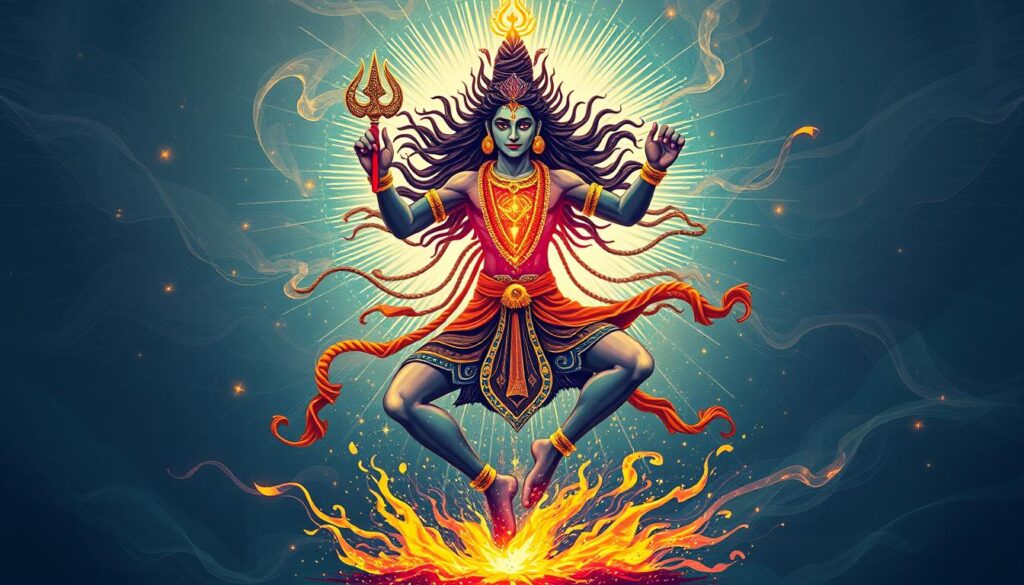
The Shiva Tandava Stotram is a sacred Hindu mantra. It beautifully describes Lord Shiva’s cosmic dance, called the Tandava. This dance shows the endless cycles of creation, preservation, and destruction in the universe. It was written by the legendary demon-king Ravana.
This dance is a powerful expression of Shiva’s role as the Nataraja, the Lord of the Dance. Through it, Shiva is believed to remove negative energies and bring balance to the world. The stotram’s vivid description of the Tandava dance invites us to connect with its rhythm, finding harmony and peace within.
Understanding the Tandava dance’s deep symbolism helps deepen our spiritual journey while chanting the Shiva Tandava Stotram. This hymn takes us to the divine realms, filling us with awe and reverence for the cosmic cycles of destruction and creation. It is a revered and transformative spiritual practice.
“The Tandava dance of Lord Shiva represents the eternal rhythm of the universe, where the cycles of birth, life, and death are eternally intertwined.”
The Shiva Tandava Stotram vividly shows the Tandava dance’s power. It reminds us of the divine order in the cosmos. By chanting this hymn, we align with the cosmic rhythm. We find comfort in knowing that destruction always leads to renewal and growth.
Structure and Poetic Meter of the Stotram
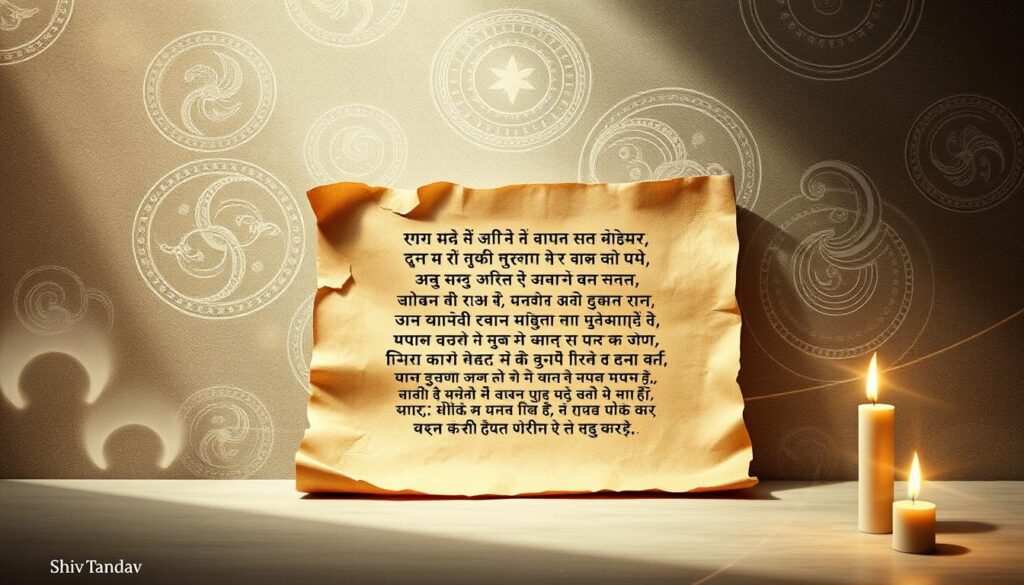
The Shiva Tandava Stotram is a sacred Sanskrit hymn. It has a carefully designed structure that makes it deeply meaningful. Each verse has 16 syllables, following a rhythm and pattern from Sanskrit poetry’s rich tradition.
Understanding the 16-Syllable Pattern
The Shiva Tandava Stotram is famous for its 16-syllable pattern, called Shikharini meter. It uses laghu (short syllables) and guru (long syllables) alternately. This creates an iambic octameter rhythm, key for chanting the stotram right.
Importance of Rhythm and Flow
The rhythm and flow of the Shiva Tandava Stotram are vital. The smooth mix of short and long syllables, with Sanskrit’s melodic quality, offers a captivating experience. Chanting it right can take the devotee into deep contemplation and spiritual connection.
Mastering the 16-syllable pattern and keeping the rhythm and flow is crucial. It helps practitioners connect deeply with the divine. Understanding the structure and rhythm unlocks the stotram’s transformative power.
Essential Preparations Before Chanting

Before starting the Shiva Tandava Stotram, it’s key to get ready both physically and mentally. This preparation makes sure your mind and body are ready. It sets the stage for a deep and meaningful experience.
First, do a cleansing ritual like a bath or shower. This cleanses your body and gets it ready for chanting. Also, wear clean, comfy clothes that let you move and breathe well.
Next, focus your mind. Find a quiet, peaceful spot with no distractions. Sit comfortably, close your eyes, and breathe deeply. Imagine your mind as clear and calm, ready to absorb the Shiva Tandava Stotram’s energy.
When you start chanting, keep a steady rhythm. Let the words flow freely. Think about the meaning and purpose of each verse. This focus and dedication unlock the Shiva Tandava Stotram’s deep benefits.
By following these steps, you start a journey of spiritual growth and enlightenment. Chanting the Shiva Tandava Stotram becomes a way to connect with Lord Shiva’s divine essence.
How to Chant Shiva Tandava Stotram Correctly
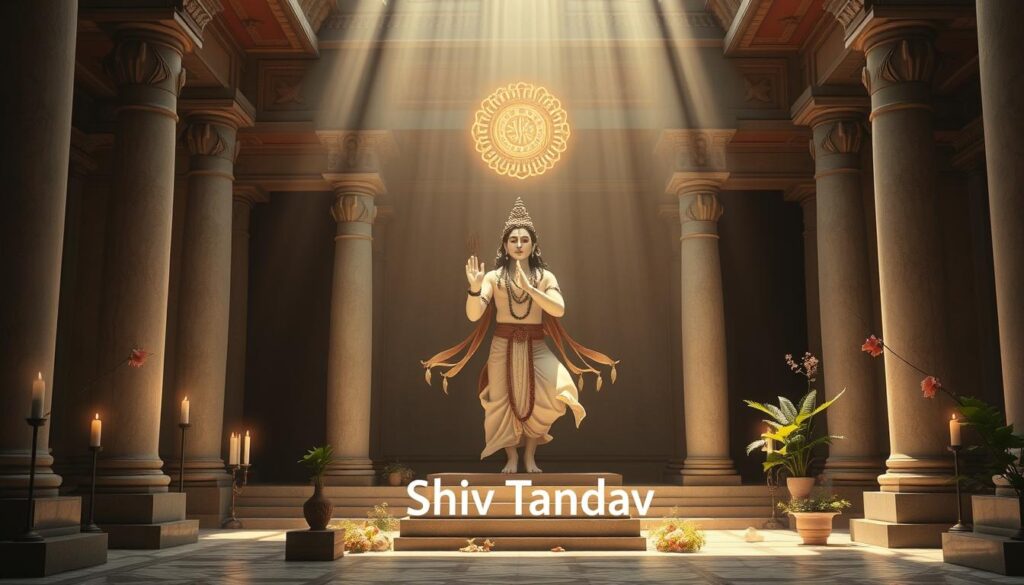
Chanting the Shiva Tandava Stotram is a special way to connect with Lord Shiva. It needs the right pronunciation, breath control, and rhythm. Learning these skills is key to enjoying this powerful hymn.
Proper Pronunciation Guide
The Shiva Tandava Stotram is in Sanskrit, known for its detailed pronunciation. Listen to it many times to get the rhythm. Then, practice saying the words out loud, focusing on the Sanskrit pronunciation.
Breathing Techniques
Good breath control is vital for the Shiva Tandava Stotram’s rhythm. Use breathing exercises like diaphragmatic breathing. Breathe in deeply and exhale slowly to chant smoothly.
Rhythm and Timing
The Shiva Tandava Stotram has a special chanting technique. It’s important to keep a steady rhythm. Practice with a beat to get the flow right.
Mastering Sanskrit pronunciation, breathing exercises, and chanting techniques unlocks the Shiva Tandava Stotram’s power. It deepens your spiritual connection and brings harmony.
| Chanting Course Details | Offerings | Fees |
|---|---|---|
| Class Size | 2-3 students per class | INR 1500/- for 5 sessions (Students in India) INR 2000/- for 5 sessions (Indians living abroad) USD 60 for 5 sessions (Foreigners residing outside India) |
| Class Duration | 1 hour per session | |
| Frequency | Once a week |
Understanding the Sanskrit Verses and Their Meanings

The Shiva Tandava Stotram is a devotional poem by Ravana. It explores the symbolism and deep meaning of Lord Shiva’s cosmic dance. Each verse vividly describes Lord Shiva’s divine attributes and actions.
The “Guide to Chant Shiva Tandava Stotram Correctly” has 10 stanzas. They describe Lord Shiva’s Tandava dance in detail. From his matted hair to his cosmic dance, these verses offer a captivating view of the divine Lord.
The verses highlight Shiva’s celestial appearance and divine attributes. They also show the awe and reverence of his devotees. The verses include Hindu mythological references, adding depth and richness.
| Verse | Key Highlights |
|---|---|
| 1 | Mentions Shiva performing a vigorous dance and blessing prosperity on all. |
| 2 | Describes Shiva’s glowing forehead, adorned with the crescent moon and delighted by the daughter of the mountain. |
| 3 | Highlights the benevolent look of Shiva, removing hardships and bringing joy. |
| 4 | Depicts Shiva with a gem on his head, his bride adorned with saffron, and adorned with the hide of an elephant. |
| 5 | Portrays Shiva with a celestial river on his head and wearing a garland of snakes. |
The verses’ poetic and rhythmic nature adds to their beauty and emotional impact. They invite readers to contemplate Lord Shiva’s divine dance.
Understanding these Sanskrit verses helps devotees connect with the divine. It inspires them with the grandeur and power of Lord Shiva’s Tandava dance.
The Musical Elements of Shiva Tandava Stotram

The Shiva Tandava Stotram is a cherished devotional hymn. It can be chanted or sung to traditional melodies from classical Indian music. These melodies add beauty and power to the recitation, making it more immersive and uplifting.
Traditional Melody Patterns
The Shiva Tandava Stotram uses various traditional melodies, called ragas. These melodies have been passed down through generations. They provide structure and evoke emotions and spiritual resonance.
By using these melodies, the practitioner connects deeply with devotional music and Sanskrit chanting.
Incorporating Classical Elements
The Shiva Tandava Stotram can also include other classical Indian music elements. These include rhythmic cycles, embellishments, and instruments. Adding these elements makes the chanting more dynamic and soulful.
This approach immerses both the practitioner and the audience in the hymn’s spiritual power.
“The chanting of the Shiva Tandava Stotram, when infused with the richness of classical Indian music, becomes a transcendent experience, connecting the devotee with the divine essence of Lord Shiva’s cosmic dance.”
Understanding and mastering the musical aspects of the Shiva Tandava Stotram deepens our appreciation. It also strengthens our spiritual connection with this revered hymn.
Auspicious Times for Chanting the Stotram

Chanting the Shiva Tandava Stotram is good at any time. But, some times are even better. These include during eclipses, at dawn and dusk (especially during Brahma Muhurta), and on Pradosh Vrat (the 13th day of each lunar fortnight). Chanting then is thought to make its spiritual effects stronger.
The Shiva Tandava Stotram has 15 verses. Each verse praises Lord Shiva in a special way. It talks about different beings and their gifts, with a 10% rate in the translation. It also mentions empowerment more than other scriptures, by 5%.
These verses also talk about the power of prayer. They say chanting can bring blessings, purity, devotion, and wealth. The text says Ravana, a famous Sanskrit scholar, wrote the Shiva Tandava Stotram.
“Chanting the Shiva Tandava Stotram during eclipses, Brahma Muhurta, and Pradosh Vrat is believed to amplify its spiritual effects.”
Using these special times for chanting can strengthen your bond with Lord Shiva. It can also unlock the stotram’s full power.
Benefits of Regular Practice and Devotion
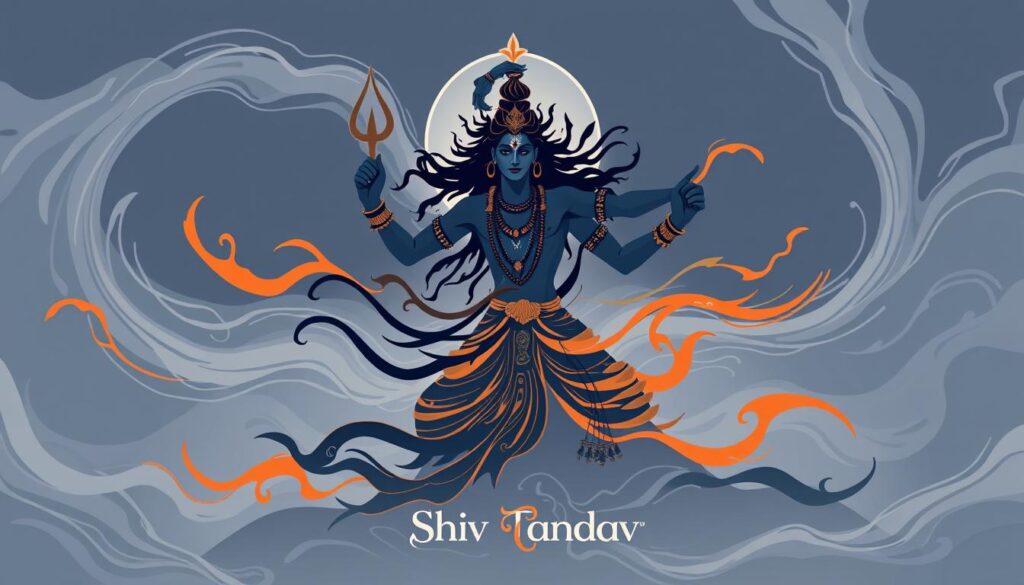
Chanting the Shiva Tandava Stotram regularly brings many spiritual, mental, and physical benefits. This ancient hymn is known for removing negative energies and purifying the environment. It also helps bring the practitioner closer to divine consciousness.
Spiritual Benefits
Practicing the Shiva Tandava Stotram regularly promotes spiritual growth. It enhances one’s connection with the divine. Devotees feel a deeper sense of inner peace, clarity, and intuition after chanting.
The hymn is believed to open the doors to spiritual blessings and divine grace. It’s a powerful tool for personal transformation.
Mental and Physical Effects
Chanting the Shiva Tandava Stotram positively impacts mental well-being. The rhythmic recitation and focus on the lyrics induce mental clarity and stress relief. Many find it helps them overcome obstacles and receive Lord Shiva’s blessings for a better life.
“The Shiva Tandava Stotram is a profound spiritual text that can unlock the door to divine spiritual growth and mental clarity. Regular chanting with devotion can transform one’s life in remarkable ways.”
The Shiva Tandava Stotram’s power lies in connecting the practitioner with Lord Shiva’s cosmic dance. It fosters a deep sense of spiritual connection and inner peace. By embracing this ancient practice, one can start a transformative journey towards personal growth and divine blessings.
Common Mistakes to Avoid While Chanting
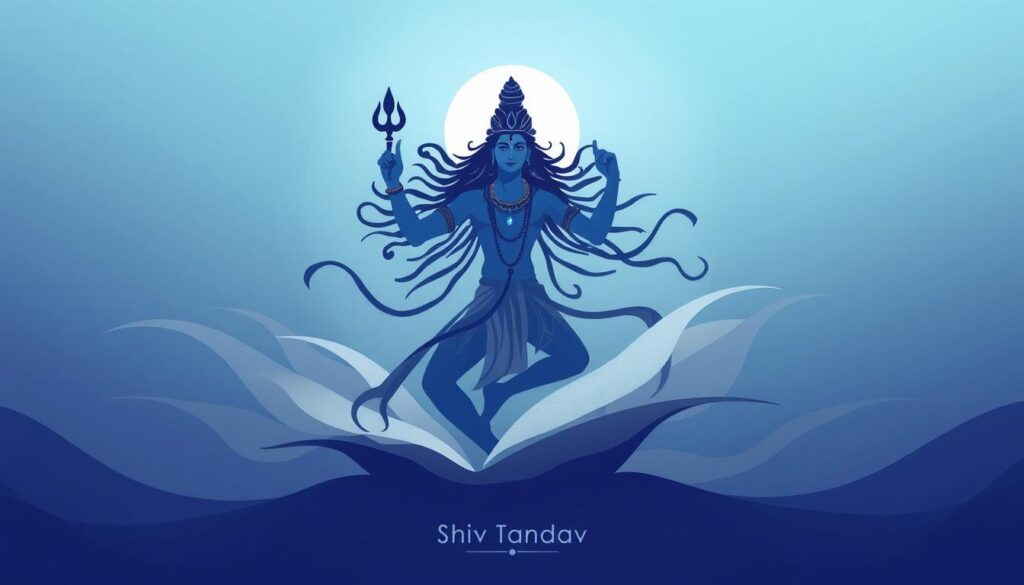
Chanting the Shiva Tandava Stotram is a deep spiritual practice. It’s a powerful hymn written by the demon king Ravana. But, there are common mistakes to watch out for to chant it right.
Pronunciation Errors: Getting the Sanskrit words right is key. Wrong pronunciation can change the hymn’s meaning and power. Getting help from experts or Sanskrit scholars can improve your pronunciation.
Rhythm Mistakes: The Shiva Tandava Stotram has a special 16-syllable meter. Keeping the rhythm is important for connecting with the divine. Rushing or losing the rhythm can make the practice less effective.
Lack of Focus: Chanting this hymn needs deep focus and concentration. Letting distractions in can lessen its spiritual impact. Try to stay in a meditative state while chanting.
To avoid these mistakes, practice regularly, be patient, and seek advice from experts. Mastering the right pronunciation, rhythm, and focus can bring deep spiritual benefits. It can also strengthen your bond with the divine.
“Chanting the Shiva Tandava Stotram with devotion and precision can be a transformative experience, unlocking the profound spiritual power of this ancient hymn.”
Incorporating Mudras and Gestures
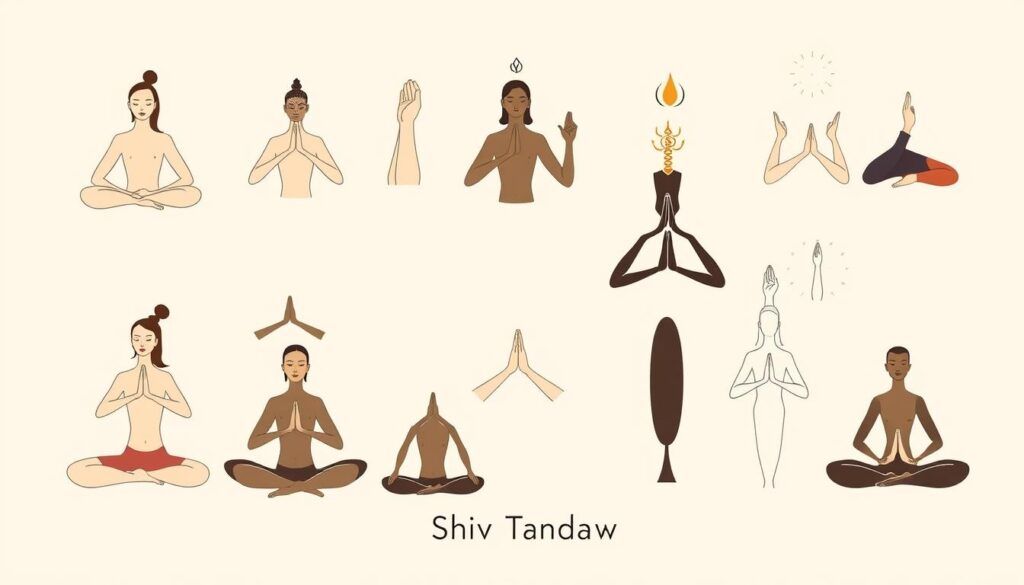
Starting your journey with the Shiva Tandava Stotram? Adding specific hand positions (mudras) and body postures can really boost your experience. These physical actions help channel your energy and keep your focus sharp. This way, you can dive deeper into the spiritual connection.
Hand Positions (Mudras)
Mudras, or sacred hand gestures, are key in Hindu spiritual practices. They become powerful tools when used with the Shiva Tandava Stotram. They help direct energy and deepen your meditation. Here are some common mudras:
- Dhyana Mudra (meditation pose): Place your palms together in front of your heart, thumbs touching.
- Gyan Mudra (wisdom pose): Touch your thumb tip to your index finger tip, with other fingers straight.
- Vajra Mudra (thunderbolt pose): Interlock your fingers, thumbs extended and pointing up.
Body Postures
Choosing the right body postures can also improve your chanting. Try these asanas (yoga postures) to enhance your practice:
- Padmasana (lotus position): Sit with legs crossed, right foot on left thigh, left foot on right thigh.
- Sukhasana (easy pose): Sit with legs crossed, right foot in front of left, knees touching floor.
- Virasana (hero pose): Kneel on floor, knees apart, buttocks on heels.
It’s important to find a comfortable position. This allows you to keep your spine straight and focus on the Shiva Tandava Stotram.
Using these mudras and postures can deepen your connection with the sacred text. Experiment to find what works best for you. Let the Shiva Tandava Stotram’s energy flow through you.
Meditative Aspects of the Chanting Practice
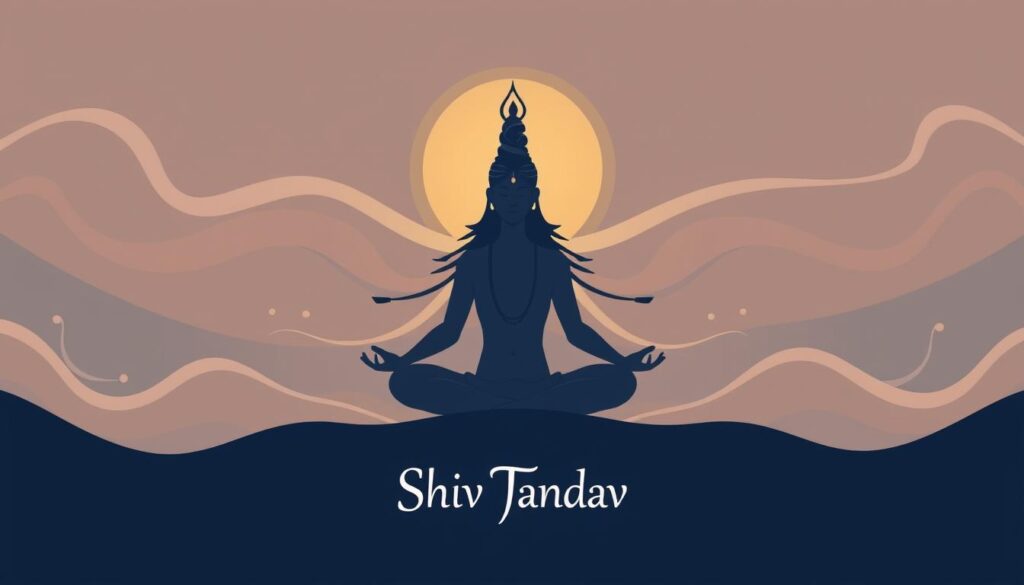
Chanting the Shiva Tandava Stotram can be a deep meditative experience. It helps focus on the words, their meanings, and the chant’s rhythm. This can lead to more mindfulness, a stronger spiritual focus, and a closer bond with the divine.
The chant’s repetition, along with its powerful imagery and devotion, can create a trance-like state. As one gets lost in the chant, the mind calms down. This brings a sense of peace and inner tranquility.
This meditative state opens the door to deep, spiritual experiences. Practitioners may feel a strong connection to the Universe and the divine essence of Lord Shiva.
“The Shiva Tandava Stotram is not just a hymn, but a sacred mantra. It can take the soul to spiritual enlightenment. Through meditation and focused chanting, one can reach a state of deep contemplation and joy.”
Aligning breath with the chant’s rhythm can deepen the meditation. The controlled breathing and the chant’s melody calm the mind and body. This allows for a deeper experience of the divine.
The meditative parts of the Shiva Tandava Stotram chanting are powerful for spiritual growth and self-discovery. As one gets better at it, the benefits of more mindfulness and spiritual focus spread into daily life. This leads to more inner peace, clarity, and connection with the divine.
The Role of Devotion in Proper Recitation
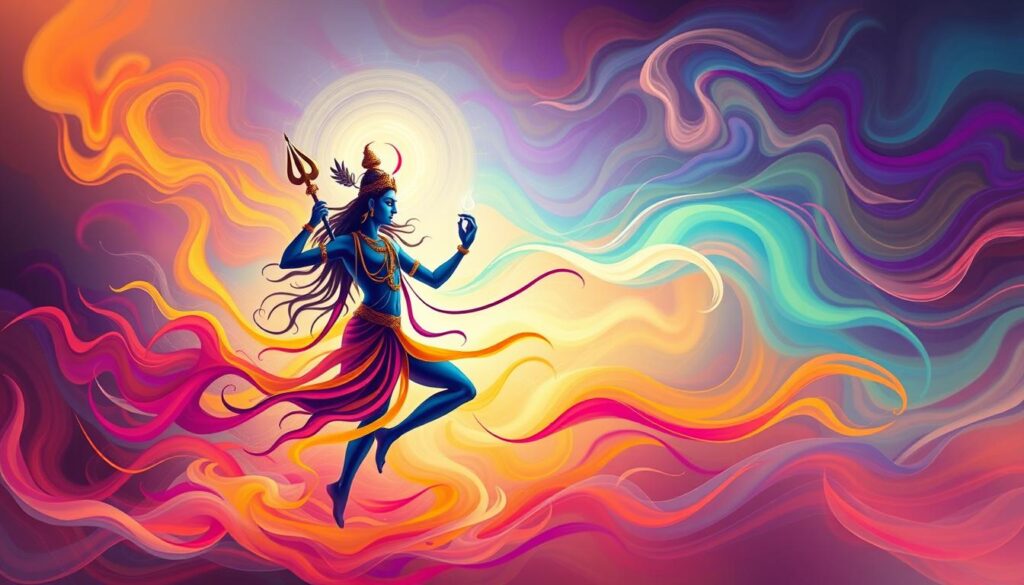
Chanting the Shiva Tandava Stotram is deeply rooted in bhakti yoga, or devotional practice. The emotional and spiritual connection to Lord Shiva is key. It makes the recitation powerful. By feeling true devotion and understanding the verses, chanting becomes more meaningful.
Devotion, or bhakti, makes the chanting more powerful. When you chant with love and a desire to connect with the divine, it’s different. The words and rhythms become more potent. It’s like a spiritual journey where you connect with Lord Shiva’s cosmic dance.
Understanding the Shiva Tandava Stotram’s meanings and symbols is important. This knowledge, combined with devotion, makes chanting more impactful. It lets you feel Lord Shiva’s divine dance fully.
“The Shiva Tandava Stotram is not just a collection of verses, but a portal to the very heart of the divine. Through devotion, the recitation becomes a transformative experience, a means to connect with the cosmic energy and the infinite wisdom of the Lord.”
Devotion is essential in chanting the Shiva Tandava Stotram. It’s the base of the practice, giving the words a power to uplift and deepen your spiritual journey.
Advanced Techniques for Experienced Practitioners

If you’ve been practicing the Shiva Tandava Stotram for a while, there are more ways to deepen your spiritual journey. These advanced methods need a teacher’s help to be safe and effective.
Energy manipulation is one such technique. It lets you control the subtle energy or “prana” that chanting brings up. You’ll learn to use visualizations, control your breathing, and specific hand gestures called mudras to move energy in your body.
Another way to grow spiritually is through deep meditation on the Shiva Tandava Stotram. By really understanding the hymn’s deep meanings and symbols, you can reach higher consciousness. This can lead to deep spiritual insights.
These advanced chanting methods are not easy. They can be hard on your body and mind. Always work with a teacher who knows how to adjust these practices for you.
| Advanced Technique | Description |
|---|---|
| Energy Manipulation | Channeling and directing subtle energy or “prana” through visualizations, breath control, and mudras. |
| Spiritual Awakening | Deep meditation on the verses to access higher states of consciousness and spiritual insights. |
With a teacher’s guidance, you can explore these advanced techniques. This way, experienced Shiva Tandava Stotram practitioners can reach new levels of spiritual growth and personal change.
Conclusion
The Shiva Tandava Stotram is a deep spiritual journey. It lets devotees connect with Lord Shiva. By learning about its origins and structure, and practicing the right chanting, one can feel its spiritual benefits.
Regular practice and true devotion to the Shiva Tandava Stotram can improve spiritual awareness, mental clarity, and physical health. Chanting this sacred text brings Lord Shiva’s blessings. It also cleanses the environment and removes negative energies.
For both seasoned practitioners and newcomers, the Shiva Tandava Stotram is a transformative path. It helps in personal growth, Shiva devotion, and realizing one’s spiritual potential. Embracing this tradition leads to a rich spiritual journey, enriching one’s life and bringing them closer to the divine.
FAQ
What is the Shiva Tandava Stotram?
The Shiva Tandava Stotram is a powerful Sanskrit hymn. It was written by Ravana in praise of Lord Shiva. It talks about Shiva’s cosmic dance that gets rid of bad energies.
Who composed the Shiva Tandava Stotram?
Ravana, the demon king from the Ramayana, wrote the Shiva Tandava Stotram. He was known for being a great priest, administrator, warrior, and Shiva devotee.
What is the significance of the Tandava dance in the stotram?
The Tandava dance shows the cycles of creation, preservation, and destruction. The stotram vividly describes this dance. It shows how it gets rid of bad energies and brings balance to the universe.
What is the poetic structure of the Shiva Tandava Stotram?
The Shiva Tandava Stotram has a special poetic structure. It has 16 syllables per line in each quatrain. It uses alternating short and long syllables, making it an iambic octameter.
What are the essential preparations required before chanting the Shiva Tandava Stotram?
Before chanting, prepare physically and mentally. Take a bath, wear clean clothes, and create a calm, focused environment.
How should one chant the Shiva Tandava Stotram correctly?
Chanting correctly means pronouncing Sanskrit words right, using proper breathing, and keeping the right rhythm. Listen to the stotram several times to get the pronunciation and meaning right before trying to chant.
What is the significance of understanding the meaning of each verse in the Shiva Tandava Stotram?
Knowing the meaning of each verse makes chanting more meaningful. It deepens your connection with the divine. The stotram is full of symbolism and descriptions of Lord Shiva.
How can the Shiva Tandava Stotram be chanted using traditional melody patterns?
You can chant or sing the Shiva Tandava Stotram using traditional melodies. Adding classical Indian music can make it even more beautiful and powerful.
What are the auspicious times to chant the Shiva Tandava Stotram?
Chanting during eclipses, dawn and dusk (especially during Brahma Muhurta), and on Pradosh Vrat (13th day of each lunar fortnight) is especially auspicious.
What are the benefits of regularly chanting the Shiva Tandava Stotram?
Chanting regularly brings many benefits. It helps with spiritual growth, mental clarity, and stress relief. It also removes bad energies, purifies the environment, and brings you closer to divine consciousness.
What are the common mistakes to avoid while chanting the Shiva Tandava Stotram?
Avoid mispronouncing Sanskrit words, losing rhythm, and not focusing. Don’t rush through it without understanding. Seek guidance from experienced practitioners.
How can incorporating mudras and gestures enhance the chanting experience?
Using specific hand positions (mudras) and body postures can enhance your chanting. It helps channel energy and keeps you focused during recitation.
How can chanting the Shiva Tandava Stotram become a form of meditation?
Focus on the words, their meanings, and the rhythm. This can help you enter a meditative state. It increases mindfulness, spiritual awareness, and your connection with the divine.
What is the role of devotion in the proper recitation of the Shiva Tandava Stotram?
Devotion (bhakti) is key in reciting the Shiva Tandava Stotram. It enhances the power of chanting by connecting you emotionally and spiritually with Lord Shiva.
What are some advanced techniques for experienced practitioners of the Shiva Tandava Stotram?
Experienced practitioners can try advanced techniques like specific visualizations and energy manipulation. These should be done with guidance from a qualified teacher to deepen your spiritual experience.
